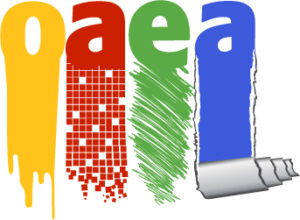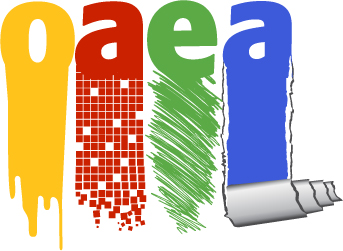Your Brain on Art: How the Arts Transform Us
by Susan Magsamen & Ivy Ross
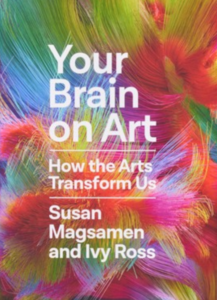 Your Brain on Art: How the Arts Transform Us, co-authors Susan Magsamen, founder, and director of the International Arts + Mind Lab at Johns Hopkins University School of Medicine, and Ivy Ross, head of hardware design at Google, focus on the neurobiology of the arts and aesthetics, and how activities from painting and dancing to expressive writing, architecture, and more enrich our lives. As Visual Art Educators, we know this to be true, and each one of us can recount the stories of demotivated students other teachers had given up on, finding remarkable connections through the arts and being transformed by these experiences.
Your Brain on Art: How the Arts Transform Us, co-authors Susan Magsamen, founder, and director of the International Arts + Mind Lab at Johns Hopkins University School of Medicine, and Ivy Ross, head of hardware design at Google, focus on the neurobiology of the arts and aesthetics, and how activities from painting and dancing to expressive writing, architecture, and more enrich our lives. As Visual Art Educators, we know this to be true, and each one of us can recount the stories of demotivated students other teachers had given up on, finding remarkable connections through the arts and being transformed by these experiences.
The book is divided into sections that focus on the language of humanity and the development of an aesthetic mindset. The difference between “makers” and “beholders” of art; How art can be a form of meditation and mindfulness; How artistic experiences can extend our lives, help treat disease, and relieve stress; and the emerging field of neuroarts and neuroaesthetics.
The authors analyze a variety of artistic pursuits that provide benefits for the brain, including poetry, music, painting, and even doodling. “Art and science together are potent medicine,” they write, “capable of radically transforming our physical health.” From young children to adults with Alzheimer’s, the arts can improve and even extend our lives.
In an essay in the Johns Hopkins Magazine, On Beauty and The Brain Author Elizabeth Evitts Dickinson (Fall 2019) quotes Susan Magsamen:
“ One of the early criticisms of studying aesthetic experience was the belief that art, owing to its inherent subjectivity, cannot be scientifically and rigorously defined. The individual response to art is highly personal. “Aesthetics means different things to different people. My sensory information, my conditioning, my genetics will be different from yours.”
Magsamen’s statement is the missing link in a series of chapters describing the importance of infusing play and nonjudgment into the art each person creates.
Each chapter begins with a significant quote. In the chapter on Restoring Mental Health Elizabeth Kubler-Ross writes, “Learn to get in touch with the silence within yourself and know that everything in this life has a purpose”. In the chapter on “Creating Community,” the authors lament previous transformational interactions that have been lost as a result of COVID-19. Now more than ever strong community bonds are critical. “Art creates culture, culture creates community, and community creates humanity.” Researchers now know that participating in, and fostering social connections in this way is akin to exercise for the brain: it improves cognition function, lowers stress, and diminishes depression. And through mirror neurons, it allowed our species to build empathy and understanding with others.
It is evident that Magsamen and Ross are both storytellers, – they tell us that storytelling triggers strong neural reactions in our brain that make us connect to the ideas being communicated, and to the person speaking.
This is a book to dip into, highlight, attach sticky notes to significant passages, and write within the margins as new and poignant encounters are narrated. To quote the authors, “Just as your brain waves oscillate with the electric energy of rhythms, just as sound and color vibrate through you, the personal choices of your aesthetic life feed and support your unique self.”
Review by Vanessa Barnett
OAEA Executive Member
Co-Artistic Director, MAMC (Making Art Making Change)
Product details
ISBN 978-0-59344923-3
Published 2023
Penguin Random House
Walter S. Allward Life & Work
by Phillip Dombowsky
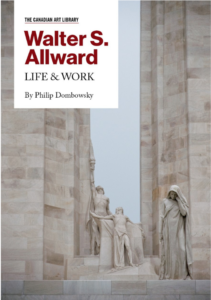 Walter S. Allward Allward is one of art history’s most talented figures, yet his name is far too little known, writes the author Phillip Dombowsky.
Indeed, how many of us have looked closely at the $20 Canadian bill that honours the Canadian National Vimy Ridge Memorial without knowing the sculptor who created this remarkable monument?
Here is a beautifully illustrated book that recounts the story Vimy Memorial, an icon of Canadian sacrifice and a legacy for future generations. My own curiosity about Allward’s Vimy Ridge memorial was peaked by reading “The Stone Carvers” (2001) a novel by the Canadian writer Jane Urquhart, focusing on the historical events of World War I, the building of the Vimy Memorial, and what Urquart calls “the redemptive nature of making art.”
“Walter S. Allward (1874–1955) was one of the most innovative modern sculptors in Canadian history. As a young man he was quick to absorb the main tenets of the current Beaux-Arts style, but his creative drive and perseverance ultimately gave rise to extraordinary forms previously unknown in Canadian sculpture. The complex and time-consuming process of producing monumental sculptures, whether in bronze or stone, demanded a high degree of skill and patience, reflected in the various techniques he used and in the appearance of his finished works.: Walter S. Allward: Life & Work is the first significant critical study of this internationally revered sculptor.”
“Intent on becoming an artist, Allward left school at the age of fourteen and within four years he had decided to focus on sculpture. He achieved success early in his career, receiving widespread praise for his design of several monuments, and ultimately developed into the foremost sculptor of his generation.”
Author Philip Dombowsky explains how Allward transformed modern sculpture to dramatic effect by combining expressive classical figures with modern compositions to create monuments that are evocative of time and place.
The book explores Allward’s early works, including the South African War Memorial in Toronto (1904–11) on Avenue Road Toronto, the Baldwin-Lafontaine Monument on Parliament Hill in Ottawa (1908–14), the Bell Memorial, commemorating Alexander Graham Bell’s invention of the telephone in Brantford (1909–17), and the Stratford War Memorial (1919–22)
The book is well set out and written in a non-academic, easily accessible style. The text contains 80 full-colour illustrations. The four chapters focus on Biography, Key Works, Significance & Critical Issues and Style & Technique
Dombowsky also provides a glossary of important terms, people, and organizations, together with an Illustrated list of public galleries and institutions where you can see the artist’s work.
What an asset this book would be to any Visual Arts library. No sculpture course would be complete without a study into the achievements one of our most prolific
A TEACHER RESOURCE GUIDE: Symbolism and Memorials through the art of Walter S. Allward
Grades 9–12 is available through ART CANADA INSITUTE .INSTITUT DE L’ART CANADIEN https://www.aci-iac.ca/education/teacher-resource-guides/symbolism-and-memorials-through-the-art-of-walter-s-allward/
“Walter S. Allward (1874–1955) was a self-taught, Toronto-born artist who became one of Canada’s pre-eminent sculptors during the first half of the twentieth century. This guide explores how symbolism and body language, including emotional expression, can be used to convey visual narratives and evoke empathy”.
Walter S. Allward Allward is one of art history’s most talented figures, yet his name is far too little known, writes the author Phillip Dombowsky.
Indeed, how many of us have looked closely at the $20 Canadian bill that honours the Canadian National Vimy Ridge Memorial without knowing the sculptor who created this remarkable monument?
Here is a beautifully illustrated book that recounts the story Vimy Memorial, an icon of Canadian sacrifice and a legacy for future generations. My own curiosity about Allward’s Vimy Ridge memorial was peaked by reading “The Stone Carvers” (2001) a novel by the Canadian writer Jane Urquhart, focusing on the historical events of World War I, the building of the Vimy Memorial, and what Urquart calls “the redemptive nature of making art.”
“Walter S. Allward (1874–1955) was one of the most innovative modern sculptors in Canadian history. As a young man he was quick to absorb the main tenets of the current Beaux-Arts style, but his creative drive and perseverance ultimately gave rise to extraordinary forms previously unknown in Canadian sculpture. The complex and time-consuming process of producing monumental sculptures, whether in bronze or stone, demanded a high degree of skill and patience, reflected in the various techniques he used and in the appearance of his finished works.: Walter S. Allward: Life & Work is the first significant critical study of this internationally revered sculptor.”
“Intent on becoming an artist, Allward left school at the age of fourteen and within four years he had decided to focus on sculpture. He achieved success early in his career, receiving widespread praise for his design of several monuments, and ultimately developed into the foremost sculptor of his generation.”
Author Philip Dombowsky explains how Allward transformed modern sculpture to dramatic effect by combining expressive classical figures with modern compositions to create monuments that are evocative of time and place.
The book explores Allward’s early works, including the South African War Memorial in Toronto (1904–11) on Avenue Road Toronto, the Baldwin-Lafontaine Monument on Parliament Hill in Ottawa (1908–14), the Bell Memorial, commemorating Alexander Graham Bell’s invention of the telephone in Brantford (1909–17), and the Stratford War Memorial (1919–22)
The book is well set out and written in a non-academic, easily accessible style. The text contains 80 full-colour illustrations. The four chapters focus on Biography, Key Works, Significance & Critical Issues and Style & Technique
Dombowsky also provides a glossary of important terms, people, and organizations, together with an Illustrated list of public galleries and institutions where you can see the artist’s work.
What an asset this book would be to any Visual Arts library. No sculpture course would be complete without a study into the achievements one of our most prolific
A TEACHER RESOURCE GUIDE: Symbolism and Memorials through the art of Walter S. Allward
Grades 9–12 is available through ART CANADA INSITUTE .INSTITUT DE L’ART CANADIEN https://www.aci-iac.ca/education/teacher-resource-guides/symbolism-and-memorials-through-the-art-of-walter-s-allward/
“Walter S. Allward (1874–1955) was a self-taught, Toronto-born artist who became one of Canada’s pre-eminent sculptors during the first half of the twentieth century. This guide explores how symbolism and body language, including emotional expression, can be used to convey visual narratives and evoke empathy”. LEARNING ACTIVITIES
- Show Me How You Feel: Body Language
- Bodies in Space: Visual Ways of Communicating
- Memory Story: Communicating through Body Language and Symbolism
RELATED SUBJECTS
- Drama, Visual Arts, Canadian History, English, Social Science, and more
- Additionally a digital copy of the book is available for downloading at: https://www.aci-iac.ca/art-books/walter-allward/
2022 Review by Vanessa Barnett
OAEA Executive Member
Co-Artistic Director, MAMC (Making Art Making Change)
Product details
ISBN 9781350096295
Published Oct 21 2021
Imprint Bloomsbury Academic
Publisher Bloomsbury Publishing
The Art Teacher's Guide to Exploring Art and Design in the Community
by Ilona Szekely
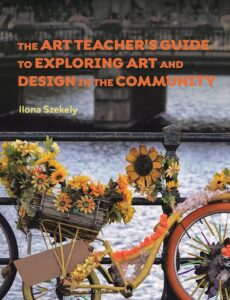
The city as inspiration for artmaking is the focus of this well-researched book.
Author Ilona Szekely asks, “How can community art build connections in diverse communities? Where is the art in contemporary libraries? How do you bring subway art into the classroom?
Szekely, an Assistant Professor in the Department of Art and Design at Eastern Kentucky University, USA, has compiled a text filled with examples from her travels over more than twenty-five years from Finland, Italy, New Zealand, Spain, and the USA. Her premise is to look beyond the classroom walls to develop meaningful art experiences for students. “She shows the myriad art forms, media expressions, and design professions that have the influence and potential to shape the local environment, reaching far beyond the traditional museum and gallery venue”.
Szekely‘s practice is a community-based approach that encourages a curriculum that focuses on “meaningful art experiences using everyday objects and diverse collective experiences”. The book enables teachers and their students to find surprises for stimulus in unexpected places. The broad ideas covered are applicable across the grades from Kindergarten through Secondary School.
Each chapter has a section on Teacher/Pedagogy as well as Talking points and Key ideas where Szekely offers practical advice and insightful comments on how each site of learning suggests an inspiration for creativity and reciprocity. – a city hotel, hospital, bank, and cinema become both the subject matter for artwork and a venue for exhibitions beyond the school.
Close looking at the environment is another focus of the book. In a delightful section, Szekely encourages her students to find inspiration in puddles, manhole covers, stairs, fences, roads, and highways. “ Large clover leaf exchanges, merging and connected routes and crossings can provide interesting visual experiences, unusual signs, asphalt patterns, and signals.”
An online link to the many projects discussed where colorful examples of the student’s work would be a valuable extension to the text. As it stands the book is a documentation of the life-changing experiences students can derive from the study of the environment and the visual breakthroughs that can occur. The notes and references are a treasure trove of research for educators, showing the remarkable breadth of the research that accompanies this robust publication.
Szekely is an Assistant Professor in the Department of Art and Design at Eastern Kentucky University, USA. She is Past President of the Kentucky Art Education Association (KyAEA), co-founder of the Center for Creative Art Teaching (CCAT), and co-sponsor of the Play Based Art Teaching movement.
Product details
ISBN 9781350096295
Published Oct 21 2021
Imprint Bloomsbury Academic
Publisher Bloomsbury Publishing
